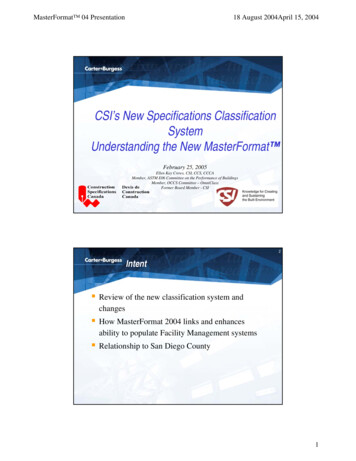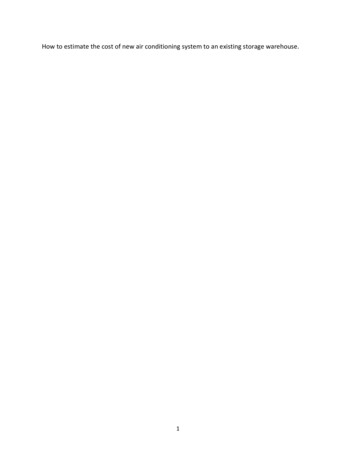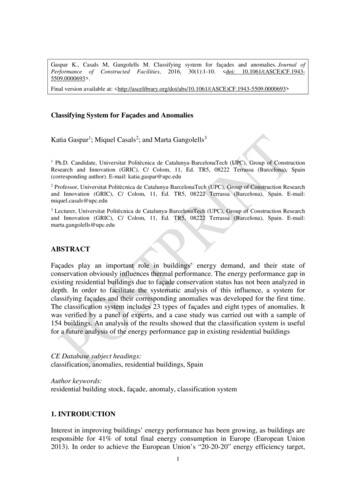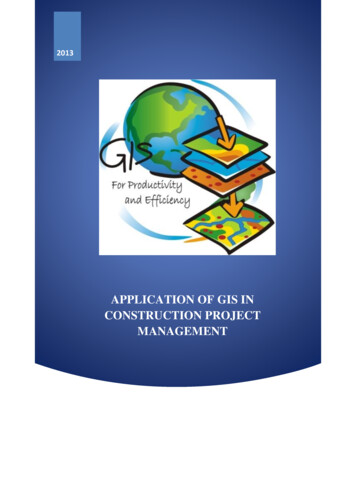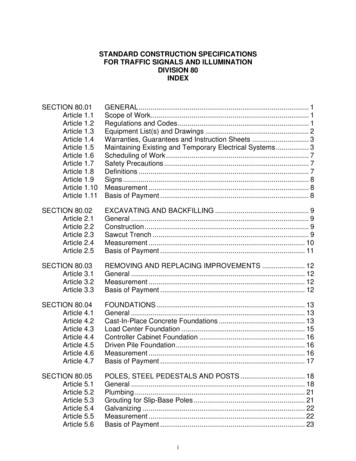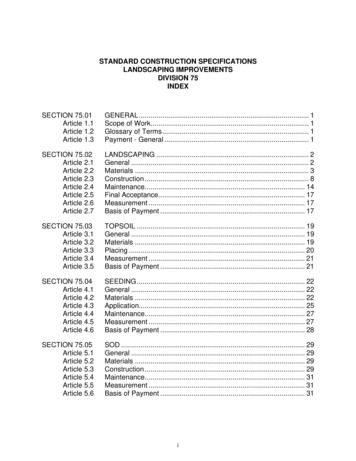
Transcription
STANDARD CONSTRUCTION SPECIFICATIONSLANDSCAPING IMPROVEMENTSDIVISION 75INDEXSECTION 75.01Article 1.1Article 1.2Article 1.3GENERAL . 1Scope of Work. 1Glossary of Terms. 1Payment - General . 1SECTION 75.02Article 2.1Article 2.2Article 2.3Article 2.4Article 2.5Article 2.6Article 2.7LANDSCAPING . 2General . 2Materials . 3Construction . 8Maintenance. 14Final Acceptance. 17Measurement . 17Basis of Payment . 17SECTION 75.03Article 3.1Article 3.2Article 3.3Article 3.4Article 3.5TOPSOIL . 19General . 19Materials . 19Placing . 20Measurement . 21Basis of Payment . 21SECTION 75.04Article 4.1Article 4.2Article 4.3Article 4.4Article 4.5Article 4.6SEEDING . 22General . 22Materials . 22Application. 25Maintenance. 27Measurement . 27Basis of Payment . 28SECTION 75.05Article 5.1Article 5.2Article 5.3Article 5.4Article 5.5Article 5.6SOD . 29General . 29Materials . 29Construction . 29Maintenance. 31Measurement . 31Basis of Payment . 31i
SECTION 75.06Article 6.1Article 6.2Article 6.3Article 6.4Article 6.5LANDSCAPE EDGING . 32General . 32Materials . 32Construction . 32Measurement . 32Basis of Payment . 32SECTION 75.07Article 7.1Article 7.2Article 7.3Article 7.4Article 7.5LANDSCAPE FABRIC . 33General . 33Materials . 33Construction . 33Measurement . 33Basis of Payment . 33SECTION 75.08Article 8.1Article 8.2Article 8.3Article 8.4Article 8.5Article 8.6Article 8.7WILLOW STAKING. 34General . 34Materials . 34Construction . 34Maintenance. 36Final Maintenance Acceptance . 37Measurement . 37Basis of Payment . 37SECTION 75.09Article 9.1Article 9.2Article 9.3Article 9.4Article 9.5SITE FURNISHINGS . 39General . 39Materials . 39Construction . 39Method of Measurement . 39Basis of Payment . 40Section 75.10Article 10.1Article 10.2Article 10.3Article 10.4Article 10.5Article 10.6MODULAR CONCRETE BLOCK WALL . 41Description . 41Materials . 41Manufacturer and Local Representative . 41Construction . 41Method of Measurement . 42Basis of Payment . 42SECTION 75.11Article 11.1Article 11.2Article 11.3Article 11.4Article 11.5BOULDERS . 43General . 43Materials . 43Construction . 43Method of Measurement . 43Basis of Payment . 43ii
STANDARD CONSTRUCTION SPECIFICATIONS FORLANDSCAPING IMPROVEMENTSDIVISION 75SECTION 75.01Article 1.1GENERALScope of WorkThe work covered by these Specifications consists of providing all plants, labor, equipment,supplies, material, transportation, handling and storage, and performing all operations inconnection with the construction of the landscaping improvements as provided for in thisDivision.Article 1.2Glossary of TermsReference the following for terminologyAppendix A. - American National Standards for Nursery Stock, ANSI Z60.1, latest edition.American Nursery and Landscape Association, 1250 I Street N.W., Suite 500, Washington,D.C., 20005.Article 1.3Payment - GeneralPayment for all Work (including the plant establishment period) included in this Divisionshall be paid for in accordance with the Division 10, Section 10.07 - Measurement andPayment, and shall include full payment for all Work described.Page 1Standard Construction SpecificationsDivision 75 – Landscaping Improvements11/08
SECTION 75.02Article 2.1A.LANDSCAPINGGeneralScope of WorkThe work under this Section consists of providing all operations pertaining to theplanting and maintenance of trees, shrubs, ground cover, perennials and annuals.The Work shall also include all operations pertaining to removing and replacingtrees and protecting existing trees in place.B.Agency Standards: NomenclatureAll operations shall meet industry consensus on the planting and care operationsand all plant materials used shall be true to name and size in conformity with thefollowing standards:1.American Standard for Nursery Stock, ANSI Z60.1 American Nursery andLandscape Association, Washington, D.C., latest edition.2.Sunset New Western Garden Book, Lane Publishing Company, Menlo Park,California, latest edition.3.Landscape Plants for Alaska, University of Alaska Fairbanks CooperativeExtension Publication, latest edition.4.ANSI Standard A300 – American National Standards for Tree CareOperations – Tree, Shrub, and other Woody Plant Maintenance – StandardPractices. American National Standards Institute, New York, New York,latest edition.5.ANSI Standard Z133 – Safety Requirements for Arboriculture AmericanNational Standard for Tree Care Operations. American National StandardsInstitute, New York, New York.6.Manual of Woody Landscape Plants, Michael A. Dirr, Stipes Publishing, LLC,th5 Edition, Champaign, Illinois.Page 2Standard Construction SpecificationsDivision 75 – Landscaping Improvements11/08
C.DefinitionThe term "planting areas" as used in this Specification, shall mean all areas to beplanted with trees, shrubs, ground cover, annuals, perennials, bulbs, native plantmaterials and/or seeded areas.Article 2.2A.MaterialsPlant Materials1.Plant ScheduleA complete schedule of plants, including quantities, sizes, and otherrequirements, is shown on the Landscape Drawings. The Contractor shallfurnish a report listing the proposed sources of the plants and location grown.In the event of plant count discrepancy between the Plant Schedule and theplants counted on the Drawings, the Drawings shall prevail. Discrepanciesbetween the quantity shown on the Plant Schedule and those required by theDrawing shall not entitle the Contractor to claim any additional compensation,nor relieve him of the obligation to complete the Work shown on theDrawings.No substitutes shall be accepted, except with the written permission of theEngineer. The Contractor shall submit all substitution requests, noting thesource of plants, location, size, and condition, within thirty (30) days ofreceiving the Notice to Proceed.Each plant shall have a durable legible label with plant size and name(genus, species, variety, cultivar) securely attached when delivered and inplace until after acceptance. Labels shall not girdle or damage plants.2.Plant Qualitya.Species and CultureAll plants shall be true to species and variety specified and nurserygrown in accordance with good horticultural practices.Plants shall be so trained in development and appearance as to becompact and symmetrical. They shall be sound, healthy, vigorous,well-branched, and densely foliated when in leaf. Plants shall be freeof disease and insect adults, eggs, pupate, or larvae. They shall havehealthy, well developed root systems and shall be free from physicaldamage or other conditions that would prevent thriving growth.All plant material shall be free of contamination by any plant notspecified, including non-native invasive plants, seeds, and plant parts.Page 3Standard Construction SpecificationsDivision 75 – Landscaping Improvements11/08
b.Tree Trunk SpecificationsTree trunks shall be straight and well-tapered. Trees with multipleleaders, unless specified, will be rejected. Damaged, cut, or crookedleaders; included bark, bark abrasions, sunscald, disfiguring knots,mold, and prematurely opened buds, or cut limbs over three-quarterinch (3/4”) diameter that are not completely callused are cause forrejection.Trunk diameter and taper shall be sufficient so that tree remainsvertical without support.c.Crown Configuration SpecificationCrown ratio (distance from bottom of canopy to tree top/tree height)should be at least sixty-six percent (66%) of total tree height.One-half (1/2) or more of the foliage should be on branchesoriginating on the lower two-thirds (2/3) of the trunk, and one-half (1/2))or less should originate on the upper one third (1/3 .d.Branch SpecificationsAll branches shall be less than two thirds (2/3) the diameter of thetrunk measured one inch (1”) above the branch.The attachment of branches shall contain no bark inclusions.There shall be one dominant leader straight to the top of the tree.Larger branches shall be spaced at least six inches (6”) apart andarranged radially and vertically along the stem.There shall be live buds or foliage to the ends of all twigs.All pruning cuts shall comply with ANSI A300 Standards and shall bemade outside the branch collar and branch bark ridge. Branchesshall not be pruned immediately prior to delivery. Needled evergreensshall not have been sheared.e.Root Flare and Root Ball SpecificationsNo root in the root ball larger than one-quarter inch (1/4”) diametershall circle more than one-third around the root ball. There shall beno roots in the root ball that make an abrupt turn of ninety degrees(90 ) or more. There shall be no roots in the root ball that are ‘J’roots, kinked, stem girdling, or potentially stem girdling. For all plants,Page 4Standard Construction SpecificationsDivision 75 – Landscaping Improvements11/08
including bare root, roots shall exhibit healthy, well-branched rootsystems characteristic of the species with adequate spread.Roots in ball-in-burlap root balls or in containers shall be well-rootedand uniform throughout soil mix or growth media. Roots of treesproduced in containers shall have been held in the container for aperiod of one growing season and no longer. Roots shall not be potbound.Major roots shall be less than two inches (2”) from the top of root flare.The root flare (trunk flare, root collar) shall be at the surface of the rootball (container media). As defined by ANSI Z60.1, root ball depthmeasurement is from the top of the ball, which in all cases shall beginat the root flare. Soil above the root flare shall not be included in balldepth measurement and should be removed.Root ball size shall meet ANSI Z60.1.Nursery Stock rot balls shall be of sufficient depth to include fibrousand feeding roots. Balls shall be securely wrapped in burlap andtightly bound with rope or twine. Trees may be wire baskets lined withburlap and tightly bound with rope or twine. Balled-in-burlap plantswith manufactured balls or container plants that are dry, cracked, orbroken before the plant operation will be rejected.The Engineer reserves the right to inspect root system of trees andshrubs and to reject any material found to be non-compliant.3.Size and Grading StandardsPlants shall have a standard balance between height, crown spread,diameter and root ball size according to the ANSI Z60.1. All plants shall betypical of their species or variety.Plants shall conform to the measurements specified except that plants largerthan those specified may be used, if approved by the Engineer. If largerplants are approved, the root ball, root spread, or container shall beincreased in proportion of the size of the plant.Caliper measurements shall be taken six inches (6”) above the trunk flare fortrees up to four inches (4”) in caliper, and 12 inches (12”) above the trunkflare for trees over four inches (4”) in caliper. Plants shall be measured whenbranches are in their normal position. If a range of size is given, no plantshall be less than the minimum size, and no less than fifty percent (50%) ofthe plants shall be as large as the maximum size specified. Plants that meetmeasurements but do not possess a normal balance between height andspread shall be rejected.Page 5Standard Construction SpecificationsDivision 75 – Landscaping Improvements11/08
Plants shall not be altered by pruning or other means to meet specifications.4.Plant CertificationAll plants shall comply with State and Federal laws governing the shipping,selling and handling of plant stock and inspection for plant diseases and pestinfestations. Plants shall be certified free from disease and infestation andinvasive weeds. Any inspection certificates required by law shall accompanyeach shipment invoiced or order of stock, and on arrival, the certificate shallbe filed with the Engineer before acceptance.5.Delivery, Storage, and HandlingAll plants shall be packed, transported, and handled with utmost care toensure adequate protection against injury or damage to the root ball, anddesiccation. Plants must be protected from excessive vibrations. Plantsshall not be thrown or bounced off a truck or loader to the ground. Plantsshall not be dragged, lifted, or pulled by the trunk or braces in a manner thatwill damage the branches or loosen the roots in the ball.Plants material transported in vehicles shall be protected from wind whippingeither by use of covered vehicle or secure tarps. Failure to protect plantmaterial during transport to the site will result in rejection of plant material.6.InspectionThe Engineer shall make periodic inspections prior to and during theinstallation and maintenance periods of the Work. All plants shall beinspected upon delivery to the job site whereupon the Engineer has the rightto reject unacceptable plant material. Should plant materials, installationprocedures, or other conditions be observed not in keeping with theDrawings, details, and these Specifications, the Engineer will direct theContractor to correct by repair, and/or replacement as appropriate. TheEngineer shall be the sole judge of the conditions of quality and acceptabilityand will direct all corrections in writing to the Contractor. All rejectedmaterials shall be immediately removed from the site and replaced withspecified materials at no additional cost to the Owner.Page 6Standard Construction SpecificationsDivision 75 – Landscaping Improvements11/08
B.MulchMulch shall consist of shredded bark mulch, wood chips or rock mulch as specifiedon the Drawings. Material shall be uniform in size, color, quality and overallappearance. Mulch shall be free of material injurious to plant growth. Sources ofmulch should be free of weeds and invasive plant parts or seeds. Sawdust, dirt,garbage, or other debris mixed in the mulch is not acceptable. Contractor shallsubmit two pounds of proposed mulch for inspection by Engineer.1.Wood ChipsWood chips shall consist of wood products having a size of two and one-halfinch (2-1/2") minus with a thickness not greater than three-eighthsinch (3/8"). Wood chips shall be uniform in overall appearance, color, quality,and size and are subject to approval by the Engineer. Wood chips are to befree of sawdust, dirt, twigs, excessive bark, or any other debris.2.Shredded Bark MulchShredded bark mulch shall consist of shredded bark and wood. Maximumlength of any individual component shall be two inches (2”) and a minimumof seventy-five percent (75%) of the mulch shall pass through a one inch (1”)screen. Mulch shall be free of germination-inhibiting ingredients. The barkmulch shall have the characteristics of retaining moisture, forming a mat notsusceptible to spreading by wind or rain, and providing a good growthmedium for plants. Shredded bark much may contain up to fifty percent(50%) shredded wood material. Wood chips are not acceptable. Bark mulchcontaining shredded wood shall be aged a minimum of one year prior toinstallation. Bark mulch shall be free of soil, rocks, and weeds.3.Rock MulchRock mulch shall be three to four inch (3” to 4”) washed river rock, uniform insize. All fines shall be screened from the aggregate within a one-quarter inch(1/4”) tolerance. Rock mulch shall be composed of round rocks that may bevaried in color. The material shall be free of organic and inorganic debrisand trash.C.Anti-desiccantsAnti-desiccants shall consist of "Wilt-Pruf" or approved equal.D.TopsoilRefer to Section 75.03, Article 3.2 - Materials.Page 7Standard Construction SpecificationsDivision 75 – Landscaping Improvements11/08
E.Fertilizer/LimeRefer to Section 75.05, Article 5.2, SubArticles B - Fertilizer and C - Limestone.F.WaterWater used for the planting, establishment, and all operations of maintenance shallbe potable. The water shall be suitable for irrigation, free from substances harmfulto plants. The Contractor shall supply a water source unless waived by writtenauthorization from the Engineer.G.Wood Stakes and TiesDeciduous Trees: Contractor shall provide two (2) stakes that are six feet (6’) inlength and are two by two inches (2” x 2”) around. Stakes shall be pointed at oneend.Evergreen Trees: Contractor shall provide three (3) stakes that are twenty-fourinches (24”) in length and are two by two inches (2” x 2”) around. Stakes shall bepointed at one end.Ties: Ties shall be of three-quarter inch (3/4”) or wider bands of polypropylene,elasticized or webbed strapping, or horticultural tape. Ties shall have a smoothsurface and be flexible to allow some movement of the trunk without damaging thebark.Article 2.3A.ConstructionNotificationContractor shall notify Engineer at least 5 (five) working days prior to delivery ofplant material to the site. Engineer shall inspect plant material prior to off-loading.B.Planting SeasonPlanting shall be done when temperatures are above freezing, the ground is frostfree, and the soil is in a workable condition. Unless otherwise specified in writing bythe Engineer, planting of trees shall be done between May 1 and October 1.C.Layout and CoordinationThe Contractor shall mark all planting areas with stakes or paint. The Engineershall approve the layout before planting begins. Contractor shall not stage plantingoperations on trails or sidewalks.The Contractor shall obtain a utility locate and ensure that utility marking is completebefore any excavation begins. The Contractor shall locate any subsurfaceimprovements such as sprinkling system or conduits. The Contractor shall bePage 8Standard Construction SpecificationsDivision 75 – Landscaping Improvements11/08
responsible for all damage resulting from neglect or failure to comply with thisrequirement.Shrubs and small trees with mature height less than fifteen feet (15’) shall beplanted at least ten feet (10’) from overhead power lines. Trees with a matureheight greater than fifteen feet (15’) but less than twenty-five (25’) shall be planted atleast fifteen feet (15’) from overhead power lines. Trees with a mature heightgreater than twenty-five feet (25’) shall be planted at least twenty feet (20’) fromoverhead power lines.The Contractor shall be responsible for moving trees if planted closer than thespecified distance. The Engineer reserves the right to relocate plant materialsbased on utility locations.D.Protection of Existing TreesContractor shall protect existing trees that are not designated for removal on theDrawings. Contractor shall disturb not more than one-third (1/3) of the root system.Contactor shall temporarily brace the tree trunk in place until the root system isbackfilled. Contractor shall thoroughly water exposed root systems and cover themwith a waterproof sheet until backfilled. Contractor shall ensure bark, branches,roots, and balls of plants are adequately protected at all times from damageincluding sun, drying winds and frost.Contractor should identify a Tree Protection Zone (TPZ) in which activities arerestricted around each existing tree that is not designated for removal on theDrawings. The TPZ shall be submitted and approved by the Engineer. The TPZboundary shall be at least thirteen feet (13’) from the trunk and a minimum depth offour feet (4’). The canopy of the tree shall be protected to the drip line. TheContractor shall not stage or store materials within the TPZ. Contractor shall ensurethat all land disturbance, excavation, trenching and grade changes, directionalboring, routing of utilities and irrigation systems, sidewalks, driveways, constructionaccess roads, changes to street lighting, fire hydrants and utility boxes takes placeoutside of the TPZ.Contractor shall ensure tree branches, trunk, and roots of existing trees areprotected during construction. Measures for protection may include effective barrierfencing, branch and/or root pruning, protective mulch, supplementary water, soilaeration and information signage.Contractor shall replace tree(s) indicated on the plan as “existing” which Contractordamages beyond repair with a four inch (4”) caliper tree (deciduous) or fourteen foot(14’) height (evergreen) of the same species, at no additional cost to the Owner.Contactor shall remove and dispose of damaged trees, and install replacementtrees in accordance with this Section. Payment for this Work is incidental to theContract.Page 9Standard Construction SpecificationsDivision 75 – Landscaping Improvements11/08
E.Existing Plant Relocation:Existing trees and shrubs designed for relocation as shown on the Drawings shallbe dug according to the applicable standards for the plant type. Plants shall bepruned, dug, balled and burlapped, containerized, or dug bare root, moved andplanted in accordance with specified tree planting requirements.Trees designated for relocation may be stored in a designated plant storage area forheeling-in of materials until final planting areas are prepared. Contractor shallmaintain plants in storage areas by bracing plants in vertical position and settingballs in an enclosed berm of topsoil or bark. Contractor shall water as required tomaintain adequate root moisture. Contractor shall re-burlap plants balls if requiredbefore final transplanting operations.F.Setting and PlantingContractor shall set balled and burlapped plants, which are not planted immediatelyupon delivery, on the ground and protect them with soil, moist shredded bark, mulchor other acceptable material. Contractor shall protect plants, if possible, from directsun until they are planted. Contractor shall keep the soil in the containers and rootballs in a moist condition.Planting pit will be a minimum radius of three (3) times the root ball diameter. Thesides of the hole will be sloped at forty-five degrees (45 ) and scarified. The depthof the planting pit will vary but shall match root ball depth.Plants shall be gently removed from containers before planting. Plants shall not bepulled from the container by the trunk.Each plant shall be planted straight and plumb per standard planting details. Allplants shall be set to ultimate finished grade, or slightly higher, so that they will beleft in the same relation to the surrounding grade as they have stood before beingmoved. Plants planted lower than the surrounding grade will be replanted tospecified grade before final inspection/approval is granted.Plants shall be set on firm soil (undisturbed or compacted) so that plant will be at thesame depth one year after planting. Any repositioning of trees shall be done bysupporting and moving the root ball, not lifting by the trunk. Plants shall be set withthe top of the root flare at or slightly above finished grade. Any soil above the rootflare must be carefully removed. The root flare shall be within one inch (1”) (aboveor below) of the soil surface. At least two roots must emerge from the trunk withinone to three inches (1” to 3”) of the soil surface, measured four inches from thetrunk.Roots that are circling the bottom, sides or surface of the root ball shall be gentlyseparated and directed away from the trunk. Roots of bare root plants shall bespread into a natural position, over a pedestal of firm soil if necessary, free ofPage 10Standard Construction SpecificationsDivision 75 – Landscaping Improvements11/08
bunching, kinking or circling. Soil shall be worked firmly into and around the rootsso that there are no air pockets. All broken or damaged roots shall be cut back tothe point where they are clean and free of rot. No other root pruning shall be done.After the plant has been set, all ropes, wire, stakes, burlap, plant labels andwrapping around the trunk or branches shall be removed.Contractor shall remove wire baskets and burlap from the planting area. If a pulpnursery pot is used, it shall be removed from the planting area.Staking is not recommended as a routine practice. Exceptions include very windysites, areas where vandalism is expected, or when planting large bare root trees inlight soil. Roots must remain stationary but the trunk shall be able to sway in thewind to develop trunk taper and strength. The Contractor shall remove staking andguying material no later than one (1) year after installation.G.Backfilling Planting Pits and Planting BedsBackfill shall be approved topsoil per Section 75.04 - Topsoil. When holes areapproximately two-thirds (2/3) full, soil shall be thoroughly watered to eliminate airpockets. Planting pits and beds shall be backfilled carefully as specified to fill allvoids and to avoid breaking root ball or bruising roots. If settling of the backfilloccurs after watering, add more backfill to bring to finish grade.H.TreesA continuous six inch (6") soil saucer
Standard Construction Specifications Division 75 – Landscaping Improvements 11/08 Plants shall not be altered by pruning or other means to meet specifications. 4. Plant Certification All plants shall comply with State and Federal laws governing the shipping, selling and handling

